How Scientists Will Break The Record For Most Distant Galaxy Ever
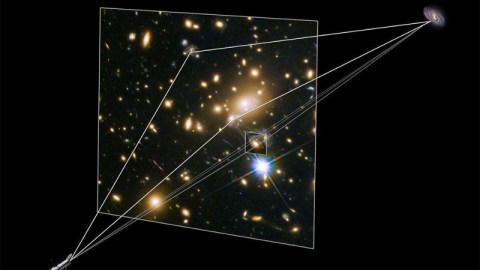
NASA’s James Webb Space Telescope will truly usher in a new era of astronomy.
If you want to find the very first galaxy of all, you have to understand not only what you’re looking for, but everything that lies in between you and the object that you’re seeking. In many ways, the science of astronomy is the study of these ever-receding cosmic horizons: the farther away we look in space, the farther back in time we see. At the absolute limits, we can imagine finding the very first stars and galaxies of all, which were the first to form in our Universe in the aftermath of the Big Bang.
Whenever we get a new tool — like a cutting-edge observatory — with new technical capabilities, our potential for new discoveries opens up, and that means the opportunity to break a host of new records. Right now, the most distant galaxy we’ve ever found is GN-z11, which was spotted by Hubble back in 2016. It’s currently located some 32 billion light-years away, and its light arrives after a 13.4 billion year journey, from when the Universe was just ~400 million years old. This record will surely fall in the era of NASA’s James Webb Space Telescope. Here’s how we’ll do it.
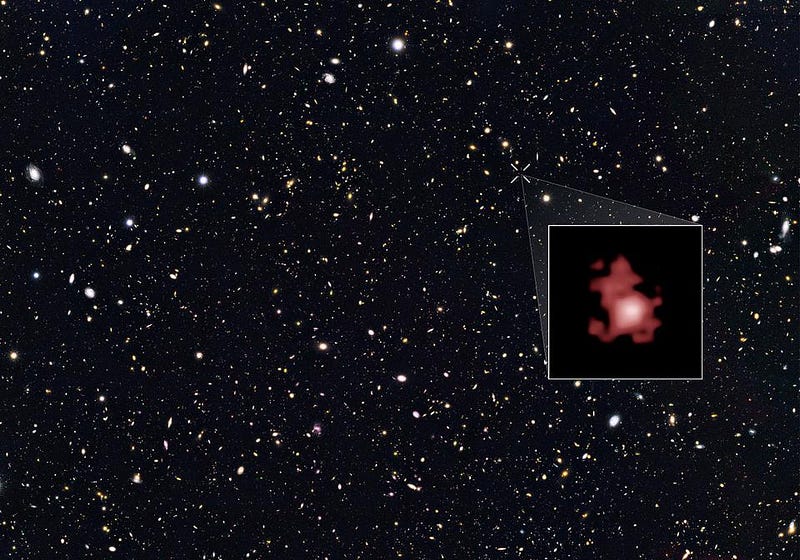
There are plenty of lessons we can learn by examining GN-z11 itself. This galaxy, intrinsically, is extremely young and bright: it’s formed a large population of new stars very recently. The light from those stars, overwhelmingly, is so bright and blue that most of it is in the ultraviolet: it’s very hot, short-wavelength radiation. And yet, the light we observe from it isn’t ultraviolet. It isn’t blue; it isn’t even visible! Instead, the only light we receive is in the infrared portion of the spectrum, and that light is very faint, muted, and exhibits a whole slew of absorption features when we break it apart into its individual wavelengths.
There are three reasons at play for why this is the case.
- The Universe is expanding, and that shifts the emitted light to longer wavelengths by the time we can observe it.
- The Universe is filled with neutral matter at these early epochs, and that absorbs a large fraction of the emitted energy before it ever gets out.
- And the Universe has intervening clouds of gas and dust that absorb a portion of the light as it journeys from the source to our eyes.
Nevertheless, even with Hubble’s antiquated instruments, we were still able to identify the current record-holder.
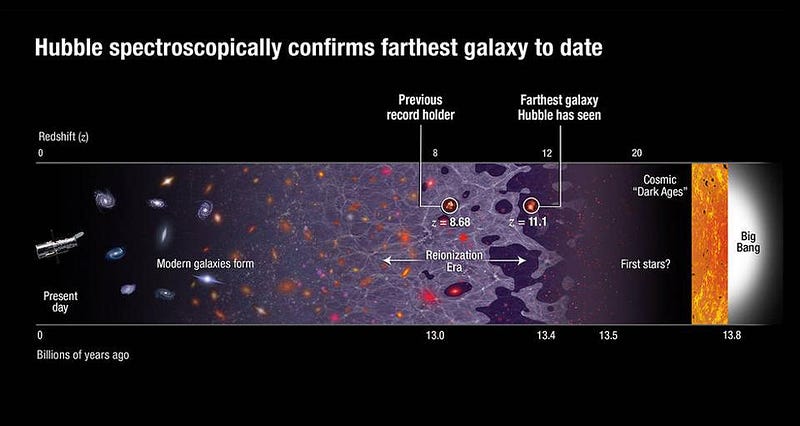
The reason we were able to see it? In some ways, we prepared for this possibility, and were able to make the most of our opportunities. But in other ways, we simply got lucky, but lucky in the best way imaginable: we put ourselves in a position where, if we did get lucky, our preparation would pay off.
Although it’s been more than a decade since its last (and final) servicing mission, Hubble is now equipped with a suite of instruments that are sensitive to a wide range of wavelengths of light: from the ultraviolet through the visible and well into the near-infrared portion of the spectrum. It not only has a wide variety of filters, allowing us to hone in on a particular set of wavelengths, but a spectrograph, enabling us to break that light up into its individual wavelengths and to look for the telltale signature of absorption and emission features: lines emitted or absorbed by electrons found in atoms and ions.
Under typical circumstances, the light that gets out would have been too faint for Hubble to see. But we got lucky in two different ways, and that made all the difference.

The first way we got lucky is that, when we look out in the direction of GN-z11, we happen to be looking along a line-of-sight that has significantly less neutral, light-blocking matter than average. This isn’t entirely unexpected: the Universe has some regions that form greater amounts of stars and galaxies early on than average, and other regions that form smaller amounts of structure than average. Those early structures — and the hot, blue, massive stars in particular — are the primarily culprit responsible for ionizing the intergalactic medium, and making it transparent to starlight.
On average, the Universe doesn’t get fully reionized (and hence, becomes transparent to starlight) until it’s reached approximately 550 million years of age. That’s how long it takes for enough stars and galaxies to form, shine, and produce sufficiently large amounts of ionizing ultraviolet radiation to knock the electrons off of 100% of the neutral atoms in the intergalactic medium, and also for the density of those ions to remain low enough so that they don’t re-form into neutral atoms. In some directions, that happens earlier (and others, later), and in the direction towards GN-z11, we got lucky and in happened significantly earlier than is typical.

If that were the only way in which we’d gotten lucky, however, we still wouldn’t have been able to discover this galaxy. Even though a larger-than-normal fraction of its ultraviolet light would have gotten out, even though there’s less intervening normal matter than typical to absorb it, and even though our current telescopes are more than capable of seeing and analyzing this light in the wavelength range in which it will arrive, it simply would have been too faint. Even with the long-period, deep-field exposures we’ve taken, it wouldn’t have been possible without an additional form of magnification.
That was where the second piece of luck came in: a gravitational lens happened to exist along the line-of-sight connecting our telescopes to this young, distant galaxy. When a large source of mass — such as a galaxy, quasar, or even a galaxy cluster — is positioned just right between ourselves and an object we’re trying to observe, it can not only stretch and distort the background light, but it can also magnify it significantly: by up to about a factor of 20. Under the best of circumstances, it can show us what would otherwise be unobservable.
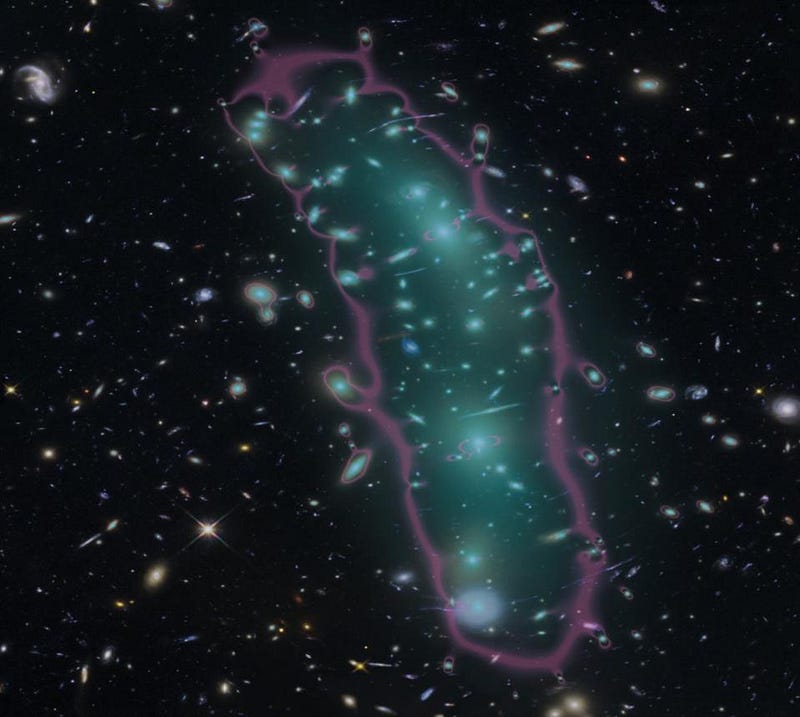
Next year, in October of 2021, NASA’s James Webb Space Telescope will launch and deploy, where it will observe the Universe far beyond the limits of Hubble. Not only is it significantly larger — with a 6.5 meter diameter (compared to Hubble’s 2.4 meters) and more than seven times the light-gathering power — but it’s also going to be both actively and passively cooled, meaning that it can see light at much longer wavelengths than Hubble can.
Those low temperatures mean low thermal noise, higher signal-to-noise ratios, and the capability of observing lower-energy, longer-wavelength light. Whereas Hubble can get out to about 2 microns in wavelength but no longer, NASA’s James Webb will go all the way out to about 25–30 microns, with greater sensitivity than Hubble at all of those wavelengths. It will be able to detect the redshifted light that’s out of Hubble’s range, enabling us to observe galaxies that are fainter, farther away, and exhibiting atomic and ionic transitions that Hubble cannot detect at all.
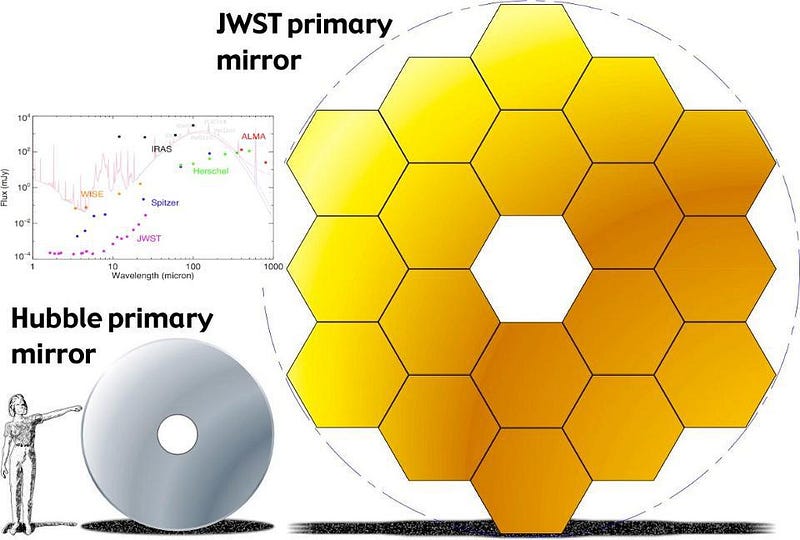
Although the scientific programme and schedule for Webb has yet to be fully determined, it’s all but certain that one of the first observing campaigns will be to do its own version of the most famous Hubble image of all: a deep-field view of a section of the Universe. In the greatest ever view of the deep Universe to date, the Hubble eXtreme Deep Field imaged a region of space so small that it would take some 32,000,000 of them to cover the full sky. Across wavelengths — from ultraviolet to visible to the near infrared — it took a total of 23 continuous days worth of data.
When all the data was in, scientists were able to construct the deepest image of the Universe ever. Within this tiny patch of sky, a total of 5500 galaxies were found, spanning billions of years of cosmic history. And yet, what’s just as remarkable is what isn’t seen. The smallest, faintest, and most distant galaxies of all were missing; with everything that Hubble was able to reveal, this still represents only about 10% of the galaxies expected to be present in this volume.

That’s where the power of NASA’s James Webb Space Telescope should truly shine. This same patch of sky, if viewed by the James Webb Space Telescope instead of Hubble, should reveal galaxies that are smaller, fainter, redder, and farther behind the great wall of only partially reionized matter than ever before. Every galaxy that Hubble was able to see should also be visible to Webb, in addition to many others.
But what we won’t know until we begin taking observations is just how many of these “missing galaxies” will be revealed. For every large, bright galaxy, there are many more that are smaller, fainter, and lower in both mass and luminosity. For every close galaxy we see today, there are many others that are farther away and less evolved.
Thanks to the power of Hubble, we’ve seen a sample of the galaxies that are out there, but they tend to be only the brightest and closest ones. With James Webb, we’ll see the ones beyond the reach of Hubble, giving us an unprecedented window into understanding how the Universe grew up to be the way it is today.

What will it reveal? That’s perhaps the biggest question of all, and one that we can only speculate about today. After all, that’s part of the fundamental essence of science: no matter how certain you are of your theories and what they predict, you must always collect the critical data from the Universe itself in order to know what’s out there. In astronomy, there is no substitute for the observations that reveal the Universe to us exactly as it is.
But nevertheless, we can be confident, based on past lessons, where we’ll be most likely to find the record-breaking galaxies that James Webb will reveal. They’ll be:
- behind a wall of neutral matter,
- that nevertheless is thinner than average,
- along a line-of-sight with fewer intervening gas clouds than normal,
- behind a massive galaxy or galaxy cluster that lenses the background light,
- as well as intrinsically bright, blue, and full of young, luminous stars.
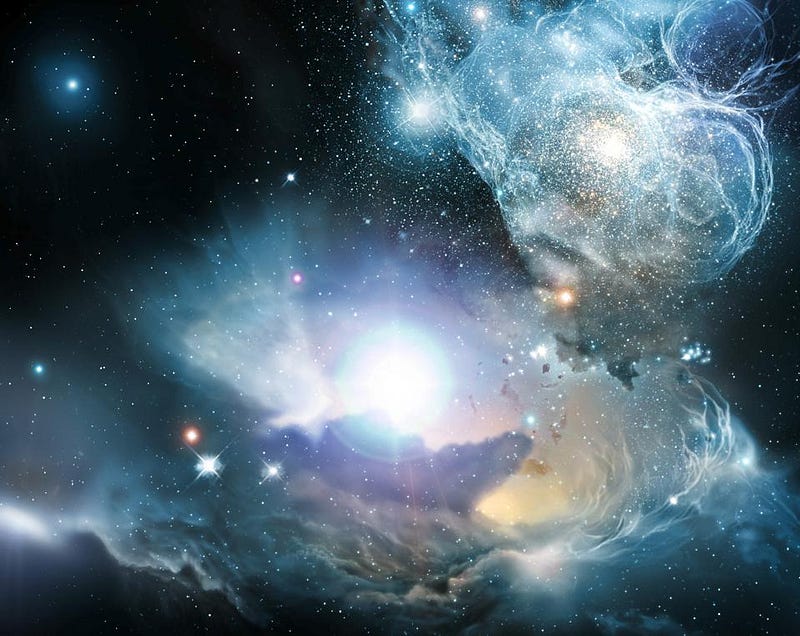
Without the ability to survey the entire sky, however, we’re extremely likely to break the current record, but not to set the ultimate, all-time, never-to-be-broken record for most distant galaxy. Even with the advanced capabilities of our next-generation space telescope, NASA’s James Webb will be able to look back to about 200–250 million years after the Big Bang: an improvement that basically halves the time since the Big Bang that Hubble can observe.
But the very first stars, star clusters, and early galaxies that form should arise even earlier than that. There’s so much intervening matter that not even Webb will be able to peer through it. There is, however a potential signal that can arise: the 21-centimeter radiation that gets emitted when stars form, matter gets ionized, and then those ions recombine to form neutral hydrogen. This radiation could, in principle, be observed by a low-frequency radio telescope array on the far side of the Moon. Our frontiers of the unknown may be always receding, but it’s up to us to keep pushing them. Only by continuing to search beyond what is presently known can we hope to discover what’s truly out there in our Universe.
Ethan Siegel is the author of Beyond the Galaxy and Treknology. You can pre-order his third book, currently in development: the Encyclopaedia Cosmologica.





